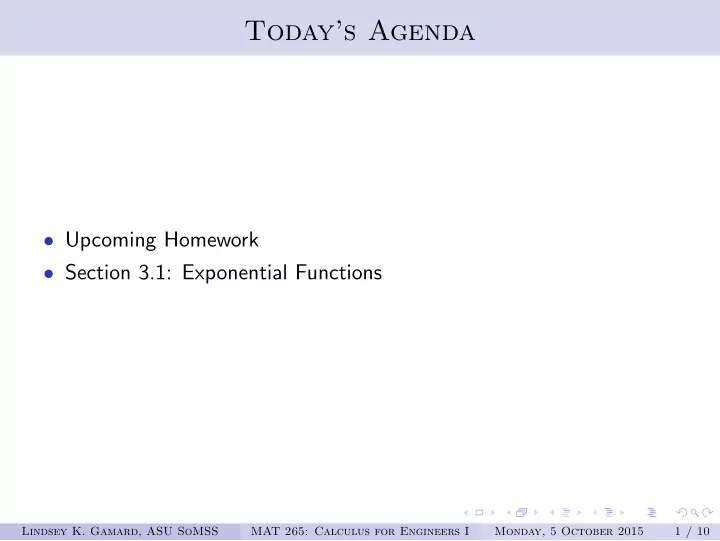

Today’s Agenda • Upcoming Homework • Section 3.1: Exponential Functions Lindsey K. Gamard, ASU SoMSS MAT 265: Calculus for Engineers I Monday, 5 October 2015 1 / 10
Upcoming Homework • Written HW F (Sections 2.7 and 2.8) due 10/7 • WeBWorK HW #12 Section 3.1 due 10/9 • WeBWorK HW #13 Section 3.2 due 10/14 Lindsey K. Gamard, ASU SoMSS MAT 265: Calculus for Engineers I Monday, 5 October 2015 2 / 10
Section 3.1 Definition 3.1.1 An exponential function is a function of the form f ( x ) = a x for a positive constant a . Recall that: • If n is a positive integer, a n = a · a · · · · · a , � �� � n times • If n is a positive integer, a − n = 1 a n , • If x is a rational number, i.e., x = p / q where p and q are integers √ and q � = 0, then a x = a p . q Lindsey K. Gamard, ASU SoMSS MAT 265: Calculus for Engineers I Monday, 5 October 2015 3 / 10
Section 3.1 We know how to define a x for any rational number x , but what if x is √ 2 ? What is 2 π ? irrational? For example, what is 5 As it turns out, the set of rational numbers are ”dense” in the set of real numbers. This means that any irrational number can be approximated by a sequence of rational numbers. (A sequence is an ordered list of numbers, possibly infinite.) The irrational number is defined as the limit of the sequence. For example, the infinite sequence of rational numbers 3.1, 3.14, 3.141, 3.1415, 3.14159, ... can be used to approximate the irrational number π . You may be surprised to find out that even though we have special names for very few irrational numbers, there are FAR more irrational numbers than rational numbers. Lindsey K. Gamard, ASU SoMSS MAT 265: Calculus for Engineers I Monday, 5 October 2015 4 / 10
Section 3.1 We can use the facts on the previous slide to define 2 π : 2 π = lim r → π 2 r , where r is rational . In general, Definition 3.1.2 If a is any positive number, we define a x = lim r → x a r , where r is rational . Lindsey K. Gamard, ASU SoMSS MAT 265: Calculus for Engineers I Monday, 5 October 2015 5 / 10
Section 3.1 Theorem 3.1.3 If a > 0 and a � = 1, then f ( x ) = a x is a continuous function with domain R and range (0 , ∞ ). In particular, a x > 0 for all x . If a , b > 0 and x , y ∈ R , 1 a x + y = a x a y 2 a x − y = a x a y 3 ( a x ) y = a xy 4 ( ab ) x = a x b x Lindsey K. Gamard, ASU SoMSS MAT 265: Calculus for Engineers I Monday, 5 October 2015 6 / 10
Section 3.1 Theorem 3.1.4 If a > 1, then x →∞ a x = ∞ x →−∞ a x = 0 . lim and lim If 0 < a < 1, then x →∞ a x = 0 x →−∞ a x = ∞ . lim and lim Lindsey K. Gamard, ASU SoMSS MAT 265: Calculus for Engineers I Monday, 5 October 2015 7 / 10
Section 3.1 You’ve no doubt heard of the number e , which is an irrational number and can be approximated (to 20 decimal places) by e ≈ 2 . 71828182845904523536 . There are many ways to define e using calculus (one way is with integrals, another way is by power series, neither of which we have learned yet). The definition we will use in our class is: x → 0 (1 + x ) 1 / x . e = lim If you are interested in learning more about the different ways to define e , you can find further information at http://mathworld.wolfram.com/e.html . Lindsey K. Gamard, ASU SoMSS MAT 265: Calculus for Engineers I Monday, 5 October 2015 8 / 10
Section 3.1 Theorem 3.1.5 The exponential function f ( x ) = e x is a continuous function with domain R and range (0 , ∞ ). Thus e x > 0 for all x . Also, x →−∞ e x = 0 x →∞ e x = ∞ , lim and lim so the x -axis is a (one-sided) horizontal asymptote of f ( x ) = e x . Example 3.1.6 e 2 x Find lim x →∞ e 2 x + 1 ( without using L’Hospital’s Rule). Lindsey K. Gamard, ASU SoMSS MAT 265: Calculus for Engineers I Monday, 5 October 2015 9 / 10
Section 3.1 1 Find the exponential function f ( x ) = Ca x such that f (1) = 6 and f (3) = 24. 2 Find the exponential function f ( x ) = Ca x such that f (0) = 2 and f (2) = 2 / 9. Calculate the following limits: 3 lim x →∞ (1 . 001) x 4 lim x →∞ e − x 2 e 3 x − e − 3 x 5 lim x →∞ e 3 x + e − 3 x 6 lim x → 2 + e 3 / (2 − x ) 7 lim x → 2 − e 3 / (2 − x ) 8 lim x → ( π/ 2) + e tan x Lindsey K. Gamard, ASU SoMSS MAT 265: Calculus for Engineers I Monday, 5 October 2015 10 / 10
Recommend
More recommend